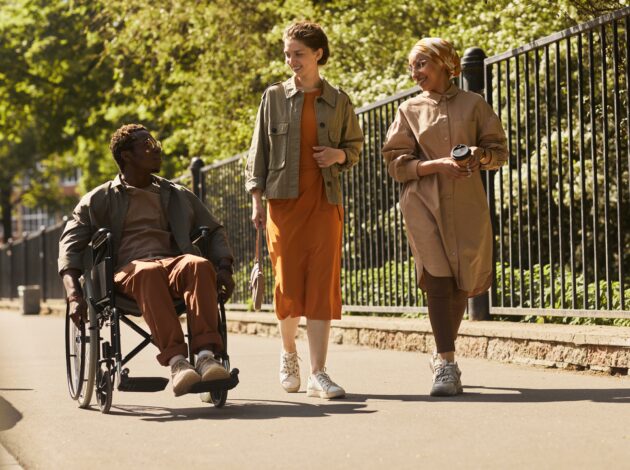Make life more inclusive: understanding disabled people’s access to activities, products and services

An important part of ONS’s work is to identify and provide insight into inequalities in society. One key area we are exploring is the lives of disabled people. We have recently published two new pieces of analysis looking at access to activities, products and services. Here, the ONS’s Beth Cook and Siannan Kerrigan explain more…
We looked at how accessibility compares for disabled and non-disabled people, using large-scale survey data for Great Britain. We also spoke to a smaller number of disabled adults from across the UK with a wide range of circumstances to understand more about what makes accessibility to activities, products and services better or worse for them.
Our lived experience research has helped to illuminate findings from our survey-based statistics and demonstrates the benefits of combining research to enhance the picture of what life is like for disabled adults. The analyses provide a range of evidence that can be used by companies, service providers and policy makers to improve accessibility for disabled adults.
Types of barriers
We found disabled adults were more likely to experience difficulty accessing products and services and face more barriers than non-disabled adults. But what does this look like in day-to-day life?
Physical access to in-person services was often reported as a barrier, with 12.5% of disabled adults taking part in the survey saying they found it difficult to move around buildings. During in-depth interviews, some participants also explained that they need to do additional planning to be able to access activities, products, and services in person:
“You have to think about everything, and how are you going to get there, where’s the parking? Is it suitable for a wheelchair? So, it’s a bit of a minefield, everything, you’ve got to plan.” Male, aged 36 to 60 years.
Not having enough places to rest when accessing in-person services was also an issue with 15.3% of disabled adults reporting this in the survey. Interviews with disabled adults shed more light on why rest spaces were important for alleviating tiredness and overstimulation:
“When I would go out into shops… I will get a sensory overload… My speech becomes really slurred and very, very slow. My body literally becomes almost paralysed. I’m very, very sore and stiff and almost just totally freeze.” Female, aged 36 to 60 years.
Accessing toilets was a further barrier, with more disabled adults reporting difficulties in our survey (13.1%) than non-disabled adults (2.2%). Interviews revealed the practical and emotional issues faced by disabled people in having to go through ‘gatekeepers’ to gain access to toilets:
“You shouldn’t need to go and get a separate key to open the toilet if you’ve got a disability. It doesn’t feel nice really and it’s like you’re different.” Female, aged 36 to 60 years.
For some disabled people, online services provided an alternative to in-person access. But accessibility could depend on how effectively the service is provided:
“Online shopping is my favourite thing ever. If there’s an online store where I don’t have to carry anything, I don’t have to touch anything, I’m able to take a break at any point…” Female, aged 18 to 35 years.
“It’s sometimes a bit of a negotiation between the delivery drivers… I do usually write, in the note, you know, ‘I have a disability, I would like you to bring the shopping to the top of the stairs.’ But, I have had times where they’ve left it outside and gone, which is infuriating.” Female, aged 36 to 60 years.
In our survey, similar proportions of disabled and non-disabled adults reported the cost of a product or service as a barrier (19.9% and 15.4% respectively). Whilst this may be due to many reasons, interviews revealed that disabled adults often face added direct and hidden financial costs such as expensive equipment and insurance, costly online delivery slots, as well as emotional, time and physical costs.
“Most insurance companies just flat out wouldn’t insure me [to travel]. If you’ve got an illness, you’re either not going or you’re going to pay through the nose.” Male, aged 18 to 35 years.
The impact of the COVID-19 pandemic and the increased move to online services
From our survey, we found that both non-disabled and disabled people identified coronavirus (COVID-19) as a barrier to accessing products and services (90.7% and 85.6% respectively).
In previous findings, disabled adults more frequently reported that the COVID-19 pandemic affected their personal well-being than non-disabled people. This included impacts such as feelings of isolation and mental health difficulties. This was also evident in disabled people’s accounts of this period, where restrictions imposed on daily life appeared to increase barriers, some of which may still remain:
“I now do a lot of meetings via Zoom, which I didn’t even know how to work before. I’ve now got a whole bunch of friends around the UK.” Female, aged 61 to 80 years.
But moving online did not always equate to greater access:
“Zoom [exercise] classes work well for many people but if you’re sight-impaired, I had to keep on getting up mid-pose or routine, to go and stick my face in the screen…” Female, aged 18 to 35 years.
Next steps
As part of widening access to our findings, we’ve just released a short video summarising the findings from our ‘Disabled people’s experiences with activities, goods and services, UK’ report.
We are planning to build on our disability data with upcoming Census analysis. This autumn we will also publish findings from qualitative research exploring the educational experiences of children with special educational needs. These plans will help to ensure everyone counts, and is counted, in our statistics.
“We’ve got a lot to say, we are a minority, but we’ve still got a lot to say. And it’s if people could listen to what we’ve got to say, we wouldn’t have so many problems in the world.” Male, aged 61 to 80 years.

Beth Cook is a Research Officer at the ONS

Siannan Kerrigan is a Research Officer at the ONS